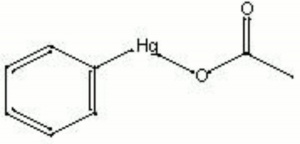Difference between revisions of "Phenylmercuric acetate"
Jump to navigation
Jump to search
(username removed) |
(username removed) |
||
| Line 38: | Line 38: | ||
* ''The Merck Index'', Martha Windholz (ed.), Merck Research Labs, Rahway NJ, 10th edition, 1983 Comment: entry 7181 | * ''The Merck Index'', Martha Windholz (ed.), Merck Research Labs, Rahway NJ, 10th edition, 1983 Comment: entry 7181 | ||
| − | * | + | * G.Caneva, M.P.Nugari, O.Salvadori, ''Biology in the Conservation of Works of Art'', ICCROM, Rome, 1991 |
[[Category:Materials database]] | [[Category:Materials database]] | ||
Revision as of 06:30, 24 July 2013
Description
White satiny crystals that have been used as a fungicide, and herbicide. Phenylmercuric acetate is no longer recommended for use due to the hazards of mercury compounds to humans and the environment.
Synonyms and Related Terms
phenyl mercuric acetate; phenyl mercury acetate; (aceto) phenyl mercury; acetoxyphenylmercury; PMA; PMAC; PMAS; Ceresan Slaked Lime; Gallotox; Liquiphene; Phix; Mersolite; Tag Fungicide; Tag HL-331; Nylmerate; Scutl; Riogen; Agrosan GN
Other Properties
Soluble in ethanol, benzene, acetone
| Composition | (CH3COO) HgC6H5 |
|---|---|
| CAS | 62-38-4 |
| Melting Point | 149 |
| Molecular Weight | mol. wt. = 336.74 |
Hazards and Safety
Highly toxic by ingestion, inhalation and skin absorption. LD50=24 mg/kg Combustible solid. Flash point 38C.
Mallinckrodt Baker: MSDS
Authority
- The Merck Index, Martha Windholz (ed.), Merck Research Labs, Rahway NJ, 10th edition, 1983 Comment: entry 7181
- G.Caneva, M.P.Nugari, O.Salvadori, Biology in the Conservation of Works of Art, ICCROM, Rome, 1991
